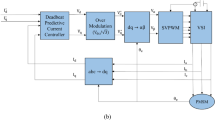Abstract
In this paper, a model predictive control (MPC) solution, assisted by extended state observer (ESO), is proposed for the common rail pressure control in gasoline engines. The rail pressure dynamic, nonlinear with large uncertainty, is modeled as a simple first order system. The discrepancy of the model from the real plant is lumped as “total disturbance”, to be estimated in real-time by ESO and then mitigated in the nonlinear MPC, assuming the total disturbance does not change in the prediction horizon. The nonlinear MPC problem is solved using the Newton/generalized minimum residual (GMRES) algorithm. The proposed ESO-MPC solution, is compared with the conventional proportional-integral-differential (PID) controller, based on the high-fidelity model provided in the benchmark problem in IFAC-E-CoSM. Results show the following benefits from using ESO-MPC relative to PID (benchmark): 1) the disturbance rejection capability to fuel inject pulse step is improved by 12% in terms of recovery time; 2) the transient response of rail pressure is improved by 5% in terms of the integrated absolute tracking error; and 3) the robustness is improved without need for gain scheduling, which is required in PID. Additionally, increasing the bandwidth of ESO allows reducing the complexity of the model implemented in MPC, while maintaining the disturbance rejection performance at the cost of high noise-sensitivity. Therefore, the ESO-MPC combination offers a simpler and more practical solution for common rail pressure control, relative to the standard MPC, which is consistent with the findings in simulation.
Similar content being viewed by others
References
L. Eriksson, L. Nielsen. Modeling and Control of Engines and Drivelines. New Jersey: John Wiley & Sons, 2002.
J. B. Heywood. Internal Combustion Engine Fundamentals. New York: McGraw-Hill, 1988.
J. Ling, H. Xie, X. Liu, et al. Design and experimental validation of a model-based rail pressure controller for common rail diesel engines. SICE Annual Conference, Hangzhou: IEEE, 2015: 752–758.
S. Xiang, Z. M. Ji, G. Q. Mo, et al. Diesel common rail pressure control based on feed forward fuzzy PID controller. Proceedings of the International Conference on Energy Science and Applied Technology, Wuhan: IEEE, 2016: 55–60.
W. Chatlatanagulchai, T. Aroonsrisopon, K. Wannatong. Robust common-rail pressure control for a diesel-dual-fuel engine using QFT-based controller. Powertrains, Fuels and Lubricants Meeting, Detroit, 2009: DOI https://doi.org/10.4271/2009-01-1799.
V. K. Gupta, Z. Zhang, Z. Sun. Modeling and control of a novel pressure regulation mechanism for common rail fuel injection systems. Applied Mathematical Modelling, 2011, 35(7): 3473–3483.
P. Lino, B. Maione, A. Rizzo. Nonlinear modelling and control of a common rail injection system for diesel engines. Applied Mathematical Modelling, 2007, 31(9): 1770–1784.
H. Chen, X. Gong, Q. Liu, et al. Triple-step method to design non-linear controller for rail pressure of gasoline direct injection engines. IET Control Theory & Applications, 2014, 8(11): 948–959.
Q. Liu, X. Gong, Y. Hu, et al. Active disturbance rejection control of common rail pressure for gasoline direct injection engine. Proceedings of the American Control Conference, Washington D.C.: IEEE, 2013: 2202–2207.
M. Du, Z. Zuo, F. Zhang, et al. Study on variable parameter linear active disturbance rejection control for GDI engine common rail pressure. IFAC Conference on Engine and Powertrain Control, Changchun, 2018: 331–336.
http://www.ascl.jlu.edu.cn/vci/info/1009/1051.htm.
J. Han. From PID to active disturbance rejection control. IEEE Transactions on Industrial Electronics, 2009, 56(3): 900–906.
Y. Hu, H. Chen, M. Liu, et al. Design and implementation of model predictive controller based on FPGA/SOPC. Chinese Journal of Scientific Instrument, 2010, 31(6): 1241–1248.
K. Song, D. Upadhyay, H. Xie. Control of diesel engines with electrically assisted turbocharging through an extended state observer based nonlinear MPC. Proceedings of the Institution of Mechanical Engineers–Part D: Journal Of Automobile Engineering, 2019, 233(2): 378–395.
K. Song, D. Upadhyay, H. Xie. An assessment of performance trade-offs in diesel engines equipped with regenerative electrically assisted turbochargers. International Journal of Engine Research, 2018: DOI https://doi.org/10.1177/1468087418762170.
Q. Liu, H. Chen, Y. Hu, et al. Modeling and control of the fuel injection system for rail pressure regulation in GDI engine. IEEE/ASME Transactions on Mechatronics, 2014, 19(5): 1501–1513.
S. Tajeddin. Automatic Code Generation of Real-time Nonlinear Model Predictive Control for Plug-in Hybrid Electric Vehicle Intelligent Cruise Controllers. Waterloo: University of Waterloo, 2016.
T. Ohtsuka. A continuation/GMRES method for fast computation of nonlinear receding horizon control. Automatica, 2004, 40(4): 563–574.
Z. Gao. Scaling and bandwidth-parameterization based controller tuning. Proceedings of the American Control Conference, Denver: IEEE, 2003: 4989–4996.
Author information
Authors and Affiliations
Corresponding author
Additional information
This work was supported by the Joint Research on Key Technologies of Energy Efficiency for Medium and Heavy-duty Trucks (No. 2017YFE0102800).
Chao WU received the M.Sc. degree in Vehicle Engineering from the School of Automotive Engineering, Wuhan University of Technology, Wuhan, China, in 2014, and currently is pursuing a Ph.D. in Power Machinery and Engineering in the School of Mechanical Engineering, Tianjin University.
Kang SONG received the Ph.D. degree in Power Machinery and Engineering in the School of Mechanical Engineering, Tianjin University, Tianjin, China, in 2015 and was doing postdoctoral program at Michigan State University, U.S.A., from September 2015 to September 2018.
Hui XIE received the Ph.D. degree in Power Machinery and Engineering in the School of Mechanical Engineering, Tianjin University, Tianjin, China, in 1998. His research interests mainly include powertrain and vehicle intelligent control, advanced algorithm and multi-core ECU, advanced combustion and control, application research of unmanned vehicle control and artificial intelligence.
Rights and permissions
About this article
Cite this article
Wu, C., Song, K. & Xie, H. Control of the common rail pressure in gasoline engines through an extended state observer based MPC. Control Theory Technol. 17, 156–166 (2019). https://doi.org/10.1007/s11768-019-8260-0
Received:
Revised:
Accepted:
Published:
Issue Date:
DOI: https://doi.org/10.1007/s11768-019-8260-0




